
In zoology, a tentacle is a flexible, mobile, elongated organ present in some species of animals, most of them invertebrates. In animal anatomy, tentacles usually occur in one or more pairs. Anatomically, the tentacles of animals work mainly like muscular hydrostats. Most forms of tentacles are used for grasping and feeding. Many are sensory organs, variously receptive to touch, vision, or to the smell or taste of particular foods or threats. Examples of such tentacles are the eyestalks of various kinds of snails. Some kinds of tentacles have both sensory and manipulatory functions.
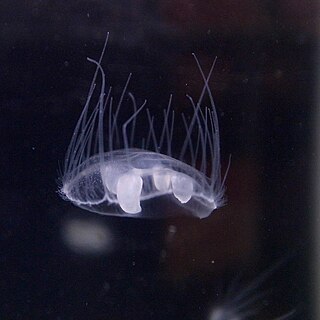
Craspedacusta sowerbii or peach blossom jellyfish is a species of freshwater hydrozoan jellyfish, or hydromedusa cnidarian. Hydromedusan jellyfish differ from scyphozoan jellyfish because they have a muscular, shelf-like structure called a velum on the ventral surface, attached to the bell margin. Originally from the Yangtze basin in China, C. sowerbii is an invasive species now found throughout the world in bodies of fresh water.

The blurred lanternshark is a little-known species of dogfish shark in the family Etmopteridae, found around the world in benthic and pelagic habitats from a depth of 110 m (360 ft) to over 1 km (0.62 mi) down. This shark forms the E. pusillus species group with the smooth lanternshark, which are distinguished from other members of its family by having irregularly arranged, flat-topped dermal denticles that give them a "smooth" appearance. Both species are slender-bodied with long heads, two dorsal fins bearing spines, no anal fins, and light-emitting photophores. The blurred lanternshark is larger, reaching 67 cm (26 in) or more in length. This species feeds on small squid, fishes, and fish eggs, and is ovoviviparous. It has been assessed as of Least Concern by the International Union for Conservation of Nature, because of its wide distribution and lack of threat from fishing pressure.

Chrysaora colorata (Russell), commonly known as the purple-striped jelly, is a species of jellyfish that exists primarily off the coast of California from Bodega Bay to San Diego. The bell (body) of the jellyfish is up to 70 cm (2.3 ft) in diameter, typically with a radial pattern of stripes. The tentacles vary with the age of the individual, consisting typically of eight marginal long dark arms, and four central frilly oral arms. It is closely studied by scientists due to not much being known about their eating habits.

Urticina crassicornis, commonly known as the mottled anemone, the painted anemone or the Christmas anemone, is a large and common intertidal and subtidal sea anemone. Its habitat includes a large portion of the coastal areas of the northern hemisphere, mainly polar regions, and it lives a solitary life for up to 80 years. Mottled anemones are similar to Dahlia anemones and both are commonly referred to as northern red anemones.

Pseudococculinidae is a family of small sea snails or false limpets, marine gastropod mollusks in the superfamily Lepetelloidea.
Teuthowenia pellucida, the googly-eyed glass squid, is a rare deep-sea glass squid whose habitat ranges throughout the oceans of the southern hemisphere.
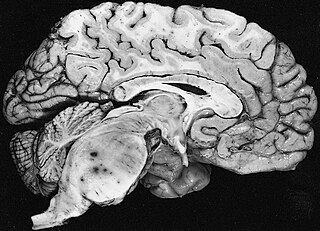
Fibrillary astrocytomas are a group of primary slow-growing brain tumors that typically occur in adults between the ages of 20 and 50.
Calliostoma bigelowi, common name Bigelow's top shell, is a species of sea snail, a marine gastropod mollusk in the family Calliostomatidae.
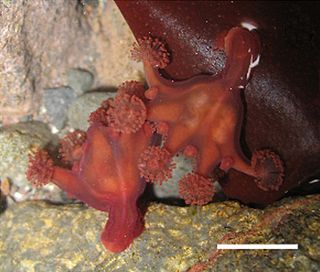
Haliclystus antarcticus is a stalked jellyfish which lives on rocky shore lines in the Southern hemisphere.

Heteractis malu, also known as the malu anemone, delicate sea anemone or white sand anemone, is a species of sea anemone in the family Stichodactylidae.

Cryptodendrum is a genus of sea anemones in the family Thalassianthidae. It is monotypic with a single species, Cryptodendrum adhaesivum, also commonly known as the adhesive anemone, pizza anemone, and nap-edged anemone. Like all symbiotic anemones it hosts zooxanthellae, symbiotic algae that help feed their host.
Maeotias is a genus of hydrozoans in the family Olindiidae. It is a monotypic genus with only a single species, Maeotias marginata, commonly known as the Black Sea jellyfish or brackish water hydromedusa and often referred to as Maeotias inexpectata in the literature. It was first described from the Don and Kuban estuaries of the Sea of Azov, and also occurs in the Black Sea, all of which are areas of low salinity. It has been recorded in several other estuarine locations around the world and is regarded as an invasive species.

Copula is a monotypic genus of box jellyfish in the family Tripedaliidae of the phylum Cnidaria. The only species in the genus is Copula sivickisi, a very small gelatinous, bell-shaped organism with four tentacles that is active only at night. It is unusual among box jellyfish in having a mating ritual and internal fertilisation. The specific name honours the Lithuanian zoologist Pranciškus Baltrus Šivickis.
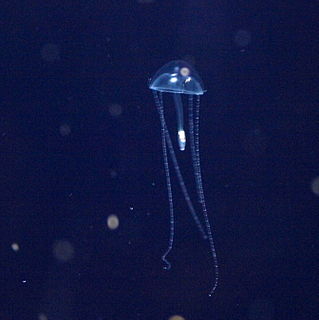
Liriope is a genus of hydrozoan in the family Geryoniidae. It contains only one species, Liriope tetraphylla.
Haliscera is a genus of hydrozoans in the family Halicreatidae.
Haliscera conica is a species of hydrozoan belonging to the family Halicreatidae.

Geryonia is a monotypic genus of hydrozoans in the family Geryoniidae. It is represented by the species Geryonia proboscidalis which occurs in the Mediterranean and subtropical seas. In the Mediterranean the species is more numerous and the polyps are larger than in other parts of the world. The diameter of a polyp can be up to 80 mm, while in Florida and the Bahamas it is rare to find specimens of more than 50 mm in diameter.

Procerodes littoralis is a species of triclad flatworm widely distributed on the shores of northwestern Europe and on the east coast of North America from Newfoundland northwards.
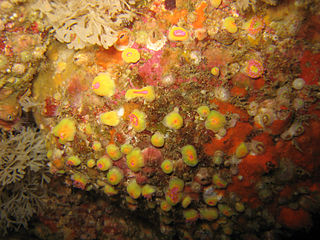
Corynactis viridis, the jewel anemone, is a brightly coloured anthozoan similar in body form to a sea anemone or a scleractinian coral polyp, but in the order Corallimorpharia. It is found in the northeastern Atlantic Ocean and the Mediterranean Sea and was first described by the Irish naturalist George Allman in 1846.















